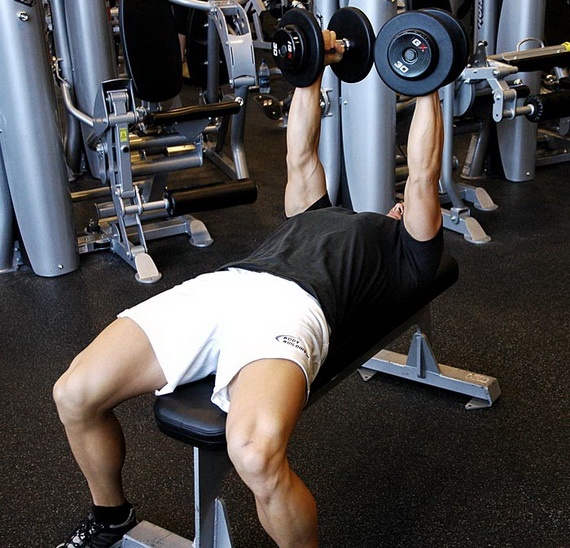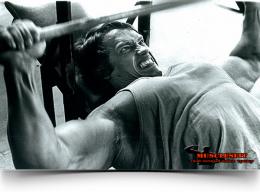75 tips to improve your bench press
Are you fed up with mediocre bench press results? Yes! Then we offer you a compilation of the most useful bench press tips found on the Web. All recommendations are short and to the point, and when applied correctly, they are really effective.
1) Stop skipping workouts. How can you seriously expect to improve strength performance if you pass by the gym and are inconsistent in your workouts?
2) Stop pressing with the “rebound” from the chest and do not let your partners lift the barbell for you. Start using full-range reps and complete sets without the help of a spotter.
3) Want to improve your bench press? Then eat more healthy food. As a rule, the more muscular the athlete, the higher his strength indicators. The more you eat, the higher your chances of making consistent progress.
4) Make sure you get enough protein, at least 180-200 grams per day. Protein deficiency in the diet limits muscle growth and.
5) When performing the bench press, the arms should be at approximately a 45° angle to the torso. Otherwise, the effectiveness of the leverage system is sharply reduced and the load on the shoulders or triceps increases. Control the position of the elbow joints.
6) Hold the bar firmly!
7) Work on increasing your grip width. A wide grip reduces the range of motion.
8) Learn and improve your bridge press technique. A bridge (back arch) also reduces the range of motion.
9) During the press, the lats and muscles of the upper back should be in a tense state. This will create a secure “support”, stabilize the body position and reduce the range of motion (compared to the bench press with a relaxed back).
10) Mentally imagine that you are doing a barbell row to your chest in the downward phase of the movement. This will help you keep your back muscles in tension.
11) Use leg momentum. Focus on planting your legs during each rep.
12) Bend the bar. Mentally bend the ends of the bar and bring them together at a central point above your body.
13) Triceps will never be too strong. Develop brute triceps strength with help and options.
14) The strength of the latissimus dorsi and back muscles does not happen much. Strong lats and a powerful back will add stability to the bench press and increase your overall pressing strength.
15) Avoid shifting the emphasis in the press to the front delts. During heavy bench presses, a colossal load is already placed on them.
16) After removing the bar from the rack, pause for 2 seconds, stabilize the position of the body, and only after that start moving the projectile down.
17) Chest - your weak point? Try .
18) Strengthen your shoulders by incorporating heavy weights into your training program.
19) The bench press should be the first exercise of your workout while you're still fresh and full of energy.
20) When scheduling your workouts, make sure your triceps have plenty of time before your bench day to fully recover from your previous shoulder/triceps workout. A common mistake inexperienced athletes make is to work their shoulders and triceps a couple of days before a training session that includes a bench press.
21) Remember that during warm-up sets you are also preparing the central nervous system for work. When the load becomes really noticeable, proceed to a gradual increase in working weight. Do not jump over warm-up weights, try to add no more than 10-20 kg per set.
22) Do 5-10 minutes of low-intensity cardio before strength training. It will increase your core body temperature, prepare your body for hard exercise, and reduce your risk of injury.
23) During warm-up sets, choose a point on the ceiling towards which you will press the barbell. During the main approaches, fix your eyes on this point and press the projectile to it. This will help you maintain a consistent barbell trajectory.
24) Rest well between sets. Remember that you are working on strength, not endurance. Rest 5 minutes between hard, exhausting sets if needed.
25) The buttocks should be pressed against the bench at all times. The separation of the buttocks during the bench press is a violation of the technique of performing the exercise.
26) Don't put your feet up on the bench during the bench press. It makes no sense, and besides, this approach will certainly reduce the weight that you can work with.
27) Never use an open grip (thumb under the bar). This technique is dangerous, in addition, you will not be able to tightly wrap around the barbell, nor mentally “bend” it.
28) The knuckles should look up. By controlling this aspect of the press, you can avoid bending or overextending your wrist.

29) Don't handle the bar gently, like a child. With all your strength, push the projectile away from your chest, as if you are trying to throw it up to the ceiling.
30) Remember, the dead center is usually a few centimeters below the point where you subjectively notice the bar is slowing down. Keep in mind that projectile slowdown starts moments before you notice it.
31) To get used to heavy weights and train the central nervous system, it is worth trying a static hold of the projectile for 10-20 seconds with a weight of about 110% of your one repetition maximum.
32) Shrugs during the bench press is another great way to develop muscles and increase results. Holding the bar at arm's length and locking your arms, move your shoulders up and down. Bench press shrugs can be performed with a load of about 110% of your bench press 1-rep max.
33) There is no need to kill yourself with a gigantic amount of workload. Use training systems that are proven to improve bench press performance and strength development, and focus on getting stronger.
34) Don't deprive yourself of sleep. Get enough sleep and try to eliminate bad habits that lead to sleep deprivation. What is more important, fighting virtual dragons before three in the morning or progressing in the bench press?

35) Be sure to include mass exercises () for all major muscle groups in your training program. The growth of muscle mass increases the power potential.
36) Listen to your body. If you're feeling overwhelmed, have a deload week or take a few extra days off.
37) Throw in a Slingshot duffel bag and use your support gear on those days when you're aching for aches and muscle tension.
38) Use wrist straps. They cost a penny, and stability is never superfluous.
39) Apply chalk to the bar and/or hands, especially if the gym is cool and the bar feels wet and slippery.
40) Cover the body's nutritional needs with basic nutritional supplements - quality and fish oil.
51) If the main problem is the initial phase of the bench press, consider adding speed work (dynamic effort) to your training program.
52) There will come a time when, for the further development of strength indicators, an unbearable load is needed. Usually in this case, workouts with a weight exceeding 80% of the one-rep maximum with one and three repetitions in the approach are connected.
53) When working with a working weight exceeding 80% of the one-rep maximum, make sure that the volume of the training load is adequate, using Prilepin's tables for this.
54) Tired of close grip bench press? Triceps bombardment with multi-rep (10-20 reps) dumbbell bench press is a worthy alternative.

55) Keep your whole body in good shape. You want muscles that are tight from head to toe, from your abs to your thighs.
56) Use the right assistance exercises. Learn how powerlifters structure their workouts for maximum bench press performance. Stop using workout routines designed by bodybuilders for bodybuilders, or by fitness fans for other fitness fans.
57) Stop training body parts and start working on specific exercises.
58) One workout per week for the bench press may not be enough. Consider cutting down on volume and upping the frequency to 2 times a week - one hard day and one medium or high rep day.
59) Find an experienced and successful powerlifter who can evaluate your efforts with a critical eye.
60) Don't try to jump over your head every time. There is no need for this, and besides, it is fraught with injuries. Stick to a training schedule and progress according to a predetermined plan.
61) Strengthen your rotator cuff with specific exercises.
62) Be smart about your choice of working weight, don't be reckless.
75) Do multi-rep sets only after lifting heavy weights, not before. During the lifting of the maximum load, you must be fresh and full of energy.






